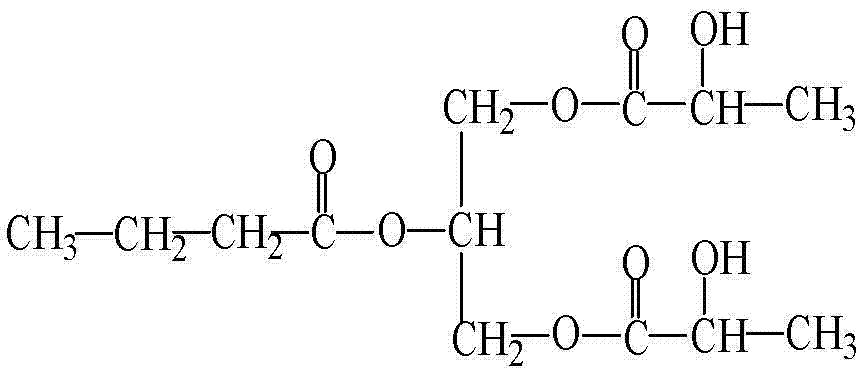Application of butyrin lactate as feed additive
A technology of glyceryl lactate and feed additives, which is applied in the fields of application, animal feed, animal feed, etc., can solve problems such as no technical solutions for glyceryl lactate have been retrieved, and improve animal production performance and intestinal morphology structure, and the effect of improving intestinal microecology
- Summary
- Abstract
- Description
- Claims
- Application Information
AI Technical Summary
Problems solved by technology
Method used
Image
Examples
Embodiment 1
[0018] A total of 100 piglets weaned at the age of 21±1 days, Du×long×big piglets were selected and randomly divided into two treatment groups (control group and test group) according to the principle of similar body weight. There were 5 replicates (pens) for each treatment, and 10 piglets per pen. The control group was fed a corn-soybean meal-based diet, and the experimental group was fed a corn-soybean meal-based diet with the addition of 0.3% lactic acid butyrate of the total weight of the feed. After feeding for 28 days, the growth performance, intestinal mucosal morphology, and intestinal tract of weaned piglets were measured. Digestive pH and colonic microbial populations. The results are shown in Table 1, Table 2 and Table 3.
[0019] Table 1 Growth performance of weaned piglets during the test period
[0020]
[0021] Note: Different lowercase letters are marked on the right shoulder of numbers in the same column, indicating significant difference (P<0.05). The f...
Embodiment 2
[0031] 200 1-day-old Cobb broilers were selected and randomly divided into two treatment groups (control group and test group) according to the principle of similar body weight. There were 5 replicates (columns) for each treatment, and 10 rats in each column (half male and half male). The control group was fed a corn-soybean meal-based diet, and the test group was fed a corn-soybean meal-based diet with the addition of 0.05% lactic acid butyric acid glyceride in the total weight of the feed. After feeding for 42 days, the growth performance, intestinal morphology and structure of the broiler chickens were measured microbial population. The results are shown in Table 4, Table 5 and Table 6.
[0032] Table 4 Growth performance of broilers during the test period
[0033]
[0034] The data in Table 4 shows that, compared with the control group, adding 0.05% lactic acid butyric acid glyceride to broiler chicken feed during the test period increased the average feed intake of b...
Embodiment 3
[0042] 240 heterogeneous gibel crucian carp with a body weight of 5.35±0.02 g were selected, randomly distributed in 8 aquariums, and divided into 2 treatment groups, and different gradient levels of glyceryl lactate (0%, 0.1% ), 4 replicates per group, 30 fish per replicate. The 8-week growth test was used to evaluate the effect of glyceryl lactate on the growth performance of the heterogeneous gibel carp. The results are shown in Table 7.
[0043] Table 7 Growth performance of heterogeneous gibel carp during the test period
[0044]
[0045] The data in Table 7 show that adding 0.1% glyceryl lactate to the diet of heterogeneous gibel carp can increase the relative weight gain rate by 10.97% and the specific growth rate by 11.68% (P<0.05), and reduce the feed coefficient by 3.40% (P<0.05 ), which promoted the growth of heterogeneous gibel carp.
PUM
 Login to View More
Login to View More Abstract
Description
Claims
Application Information
 Login to View More
Login to View More - R&D
- Intellectual Property
- Life Sciences
- Materials
- Tech Scout
- Unparalleled Data Quality
- Higher Quality Content
- 60% Fewer Hallucinations
Browse by: Latest US Patents, China's latest patents, Technical Efficacy Thesaurus, Application Domain, Technology Topic, Popular Technical Reports.
© 2025 PatSnap. All rights reserved.Legal|Privacy policy|Modern Slavery Act Transparency Statement|Sitemap|About US| Contact US: help@patsnap.com



